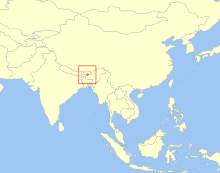| Gee's golden langur[1] | |
|---|---|

| |
| Scientific classification | |
| Domain: | Eukaryota |
| Kingdom: | Animalia |
| Phylum: | Chordata |
| Class: | Mammalia |
| Order: | Primates |
| Suborder: | Haplorhini |
| Infraorder: | Simiiformes |
| Family: | Cercopithecidae |
| Genus: | Trachypithecus |
| Species: | T. geei
|
| Binomial name | |
| Trachypithecus geei (Khajuria, 1956)
| |
| Subspecies[1] | |
| |

| |
| Gee's golden langur geographic range | |
Gee's golden langur (Trachypithecus geei), also known as simply the golden langur, is an Old World monkey found in a small region of Western Assam, India and the neighboring foothills of the Black Mountains of Bhutan. Long considered sacred by many Himalayan people, the golden langur was first brought to the attention of the Western world by the naturalist Edward Pritchard Gee in the 1950s. Adult males have a cream to golden coat with darker flanks while the females and juveniles are lighter. The golden langur has a black face and a long tail up to 100 cm (39 in) in length. It lives in high trees and has a herbivorous diet of fruits, leaves, seeds, buds, and flowers. The average group size is eight individuals, with a ratio of several females to each adult male. It is one of the most endangered primate species of India and Bhutan.
In 2008-09, there were 6,000 golden langurs in India, which has grown to 7,396 in 2020-21.[4]
- ^ a b Groves, C. P. (2005). Wilson, D. E.; Reeder, D. M. (eds.). Mammal Species of the World: A Taxonomic and Geographic Reference (3rd ed.). Baltimore: Johns Hopkins University Press. p. 176. ISBN 0-801-88221-4. OCLC 62265494.
- ^ Das, J.; Medhi, R. & Molur, S. (2008). "Trachypithecus geei". IUCN Red List of Threatened Species. 2008: e.T22037A9348940. doi:10.2305/IUCN.UK.2008.RLTS.T22037A9348940.en.
- ^ "Appendices | CITES". cites.org. Retrieved 14 January 2022.
- ^ Karmakar, Rahul (9 March 2024). "India's golden langur population estimated at 7,396". The Hindu. ISSN 0971-751X. Retrieved 11 March 2024.
